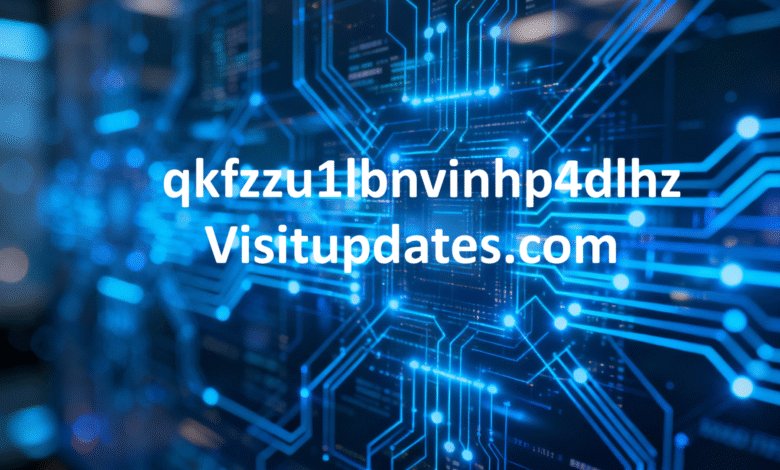Unlocking the Power of qkfzzu1lbnvinhp4dlhz: Everything You Need to Know for 2025

In the rapidly qkfzzu1lbnvinhp4dlhz evolving digital landscape of 2025, unique identifiers and encoded strings have become increasingly important for data management, security protocols, and system architecture. The string qkfzzu1lbnvinhp4dlhz represents a fascinating example of how modern technology leverages alphanumeric sequences for various purposes. Whether you’re a developer, data analyst, or simply curious about digital infrastructure, understanding these coded sequences can unlock new perspectives on how information flows through our interconnected world.
What is qkfzzu1lbnvinhp4dlhz?
The term qkfzzu1lbnvinhp4dlhz is an alphanumeric string that follows common patterns used in modern computing systems for identification, encryption, or data encoding purposes. Such strings typically consist of lowercase letters and numbers arranged in a specific sequence, often generated through algorithmic processes to ensure uniqueness. In practical applications, strings like qkfzzu1lbnvinhp4dlhz serve as identifiers for database entries, session tokens, encrypted parameters, or hashed values that maintain data integrity across digital platforms. The combination of random-appearing characters makes these strings virtually impossible to guess or replicate, which is precisely why they’re so valuable in contemporary technology stacks.
The Technical Foundation Behind Encoded Strings
Encoded strings like qkfzzu1lbnvinhp4dlhz are typically generated using cryptographic hash functions, random number generators, or base64 encoding algorithms. These methods transform input data into fixed-length or variable-length strings that appear random but follow mathematical principles ensuring consistency and security. Hash functions such as SHA-256, MD5, or more modern alternatives create these strings by processing input through complex mathematical operations that produce unique outputs. The beauty of this approach lies in its one-way nature—while you can easily generate the encoded string from source data, reversing the process without the original key or algorithm parameters is computationally infeasible.
The specific structure of qkfzzu1lbnvinhp4dlhz suggests it may be base64-encoded or generated through a custom algorithm designed for URL-safe strings. Base64 encoding converts binary data into ASCII characters using a 64-character subset, making it ideal for transmitting data through systems that only support text. This encoding method ensures that special characters or binary information can travel safely through email systems, URLs, or JSON APIs without corruption or misinterpretation.
Common Applications in Modern Technology
Strings similar to qkfzzu1lbnvinhp4dlhz appear throughout modern technology infrastructure in numerous critical applications. Session management systems use these identifiers to track user activities across web applications, ensuring that your shopping cart remains intact or your login session persists as you navigate between pages. Database systems employ such strings as primary keys or unique identifiers, allowing millions of records to coexist without conflicts while maintaining lightning-fast lookup capabilities. Cloud storage platforms generate similar strings as file identifiers or access tokens, enabling secure sharing and retrieval of documents without exposing underlying file structures.
Authentication systems heavily rely on encoded strings for generating temporary tokens, password reset codes, and API keys that grant programmatic access to services. The randomness inherent in strings like qkfzzu1lbnvinhp4dlhz makes them excellent candidates for preventing brute-force attacks or unauthorized access attempts. Additionally, blockchain technologies and distributed systems use comparable encoding schemes for transaction IDs, wallet addresses, and smart contract references, demonstrating how these simple-looking strings underpin some of the most sophisticated technologies of our time.
Security Implications and Best Practices

The security value of strings like qkfzzu1lbnvinhp4dlhz cannot be overstated in an era where data breaches and cyber attacks dominate headlines. The entropy—or randomness—contained within these strings directly correlates to their resistance against prediction or brute-force enumeration. A well-generated identifier should contain sufficient length and character variety to make guessing statistically impossible within any reasonable timeframe. For instance, a 20-character string using lowercase letters and numbers offers approximately 36^20 possible combinations, which equals a number so astronomically large that even modern supercomputers would require millions of years to test every possibility.
However, security professionals must implement these identifiers correctly to maintain their protective qualities. Strings should be generated using cryptographically secure random number generators rather than predictable algorithms or sequential patterns. They should never be reused across different contexts or applications, as this practice could create correlation opportunities for attackers. Time-based expiration, proper storage in encrypted databases, and secure transmission over HTTPS channels further enhance the security posture of systems utilizing such identifiers.
Performance Considerations in Data Systems
When working with identifiers like qkfzzu1lbnvinhp4dlhz at scale, performance becomes a critical consideration that can make or break system efficiency. Database indexing strategies must account for the random nature of these strings, as traditional B-tree indexes may suffer from page splits and fragmentation when dealing with non-sequential keys. Many high-performance systems opt for UUID-based approaches or composite keys that balance uniqueness with index efficiency, ensuring that lookup operations remain fast even as datasets grow into billions of records.
Caching strategies also play a vital role in optimizing performance when these identifiers serve as session tokens or frequent lookup keys. In-memory data stores like Redis or Memcached excel at providing microsecond-level access to values associated with string keys, dramatically reducing database load and improving user experience. Load balancing and distributed caching solutions must maintain consistency across multiple servers, ensuring that the same identifier returns identical results regardless of which server handles the request.
Integration with APIs and Web Services
Modern web services and APIs extensively utilize encoded strings similar to qkfzzu1lbnvinhp4dlhz for managing access control, tracking requests, and maintaining stateless architectures. RESTful APIs commonly include such strings in URL paths or query parameters to specify resources, while GraphQL implementations might use them as unique identifiers in query responses. OAuth 2.0 authentication flows generate comparable access tokens and refresh tokens that clients exchange for authorized API access, demonstrating how these strings facilitate secure communication between distributed systems.
Webhook implementations and callback mechanisms rely on unique identifiers to correlate responses with original requests, especially in asynchronous processing scenarios where immediate responses aren’t feasible. Payment gateways, third-party integrations, and microservices architectures all depend on these identifying strings to maintain transactional integrity and enable reliable communication patterns. Developers must carefully design their API schemas to handle these identifiers efficiently while providing clear documentation that helps consumers understand how to work with encoded strings in various contexts.
Data Privacy and Compliance Considerations
In the context of data privacy regulations like GDPR, CCPA, and emerging global standards, strings like qkfzzu1lbnvinhp4dlhz play an important role in pseudonymization strategies. By replacing personally identifiable information with random identifiers, organizations can process data for analytics or testing purposes while minimizing privacy risks. This approach allows data teams to perform valuable analysis without directly exposing sensitive customer information, striking a balance between utility and protection.
Compliance frameworks often require audit trails that track data access and modifications, and unique identifiers serve as the backbone of these logging systems. Every action within a regulated system can be tagged with relevant identifier strings, creating an immutable record that demonstrates accountability and enables forensic investigation when necessary. Organizations must implement proper key management practices, ensuring that the mapping between identifiers and actual user data remains secure and accessible only to authorized personnel.
Future Trends and Evolution
Looking ahead through 2025 and beyond, the role of encoded strings like qkfzzu1lbnvinhp4dlhz will likely evolve alongside emerging technologies and computing paradigms. Quantum computing poses both challenges and opportunities for cryptographic string generation, as quantum algorithms could potentially crack current encryption methods while simultaneously enabling new approaches to secure identifier creation. Post-quantum cryptography research aims to develop string generation methods resistant to quantum attacks, ensuring that our digital infrastructure remains secure as technology advances.
Artificial intelligence and machine learning systems increasingly rely on unique identifiers for tracking model versions, training datasets, and inference results. As edge computing and Internet of Things ecosystems expand, the need for efficient, collision-resistant identifiers grows exponentially with billions of devices requiring unique identification. Decentralized identity systems and self-sovereign identity protocols will likely leverage similar encoding schemes to empower individuals with control over their digital identities while maintaining interoperability across platforms and services.
Practical Implementation Guidelines
For developers and system architects working with strings similar to qkfzzu1lbnvinhp4dlhz, several practical guidelines can ensure robust and maintainable implementations. Always use established libraries and frameworks for generating random strings rather than attempting custom implementations that might introduce vulnerabilities or predictability. Document the purpose and lifecycle of each identifier type within your system, making it clear which strings are temporary session tokens versus permanent database keys. Implement proper validation and sanitization routines to prevent injection attacks when these strings arrive as user input, even though their random nature provides inherent protection against many attack vectors.
Consider implementing identifier versioning schemes that embed metadata within the string structure itself, allowing future systems to understand the format and generation method used. Monitor identifier usage patterns to detect anomalies that might indicate security issues or system malfunctions, such as excessive failed lookup attempts or suspicious patterns in identifier requests. Regular security audits should review identifier generation, storage, and transmission practices to ensure they align with current best practices and organizational security policies.
Conclusion
The world of encoded strings like qkfzzu1lbnvinhp4dlhz may seem abstract, but these simple sequences of characters form the invisible backbone of modern digital systems. From securing user sessions to enabling scalable database architectures, from protecting privacy through pseudonymization to facilitating seamless API communications, these identifiers touch nearly every aspect of contemporary technology. As we progress through 2025, understanding how these strings function, why they matter, and how to implement them effectively becomes increasingly important for anyone working in technology fields. By appreciating the careful design and thoughtful implementation behind seemingly random character sequences, we gain deeper insight into the sophisticated systems that power our connected world.



